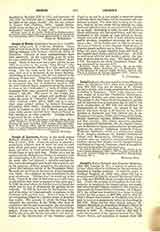

Joseph‘s, Saint, SOCIETY FOR FOREIGN MISSIONS, (Mill Hill, London, N. W.), a society of priests and laymen whose object is to labor for the conversion of heathens in foreign countries. It owes its origin to Cardinal Vaughan (d. 1903) who, when still but a priest, founded in 1866 St. Joseph‘s Missionary College in a villa near Mill Hill, about ten miles north of London. It was the purpose of this college to train missionaries to propagate the Gospel among unevangelized races beyond Europe, especially the negroes of Africa and the United States of America. On March 1, 1871, the college was transferred to a larger building erected for the purpose at Mill Hill, and in 1884 St. Peter’s School was founded at Freshfield near Liverpool, to serve as a preparatory school to the college at Mill Hill. There are two other branch colleges: St. Joseph‘s Missiehuis, at Rozendaal, Holland, erected in 1890; and St. Josefs Missionshaus, at Brixen, Tyrol, erected in 1891. St. Joseph‘s Society, Mill Hill, is under the direction of the superior general, Very Rev. Francis Henry, and comprises at present about 200 priests and 10 lay brothers. About 170 of these priests are engaged as missionaries, the others as teachers in the above named colleges. The following missions are under the care of the society: the Telugu Mission in the Archdiocese of Madras in British India, since 1875; the Prefecture Apostolic of Labuan and North Borneo, since 1881; the Maori Mission in the Diocese of Auckland, New Zealand, since 1886; the Prefecture Apostolic of Kafiristan and Kashmir in the northern part of India, since 1887; the Vicariate Apostolic of the Upper Nile or Uganda in British East Africa, since 1894; a few stations in the Belgian Congo, since 1903; and in the Diocese of Jaro, in the Philippine Islands, since 1906, there are about thirty priests of the society. The rules and constitutions of the society received the final definite approval of the Holy See April 25, 1908.SISTERS OF ST. JOSEPH’S SOCIETY FOR FOREIGN MISSIONS, of the Third Order Regular of St. Francis, founded in 1883 by Cardinal Vaughan and Mother Mary Francis Ingham, to cooperate in the work of the Mill Hill Fathers. The cardinal’s idea was that the sisters should stand in the same relation to the fathers of the society as the Sisters of Charity of St. Vincent de Paul to the Lazarist Fathers. They undertake any work, at home or abroad, indicated for them by the superior general or the bishop of the diocese. There are no lay sisters. The novitiate is at Patricraft, Manchester, where the sisters have also homes for boys and girls and a nursery, with about 200 children under 40 sisters. In addition to their establishments at Mill Hill and Manchester, the congregation has a branch house at Blackburn with boarding-schools for boys and girls of the middle class and an orphanage for children of the poorer class, with 10 sisters in charge of 70 to 80 children; at Blackburn the sisters teach in 3 elementary schools. They have branches also at Freshfield (Liverpool), at Waterford and Cork in Ireland, and at Rozendaal in Holland. In Borneo there are 17 sisters at various mission stations. The total number of professed sisters in the congregation is 120.
MICHAEL OTT

